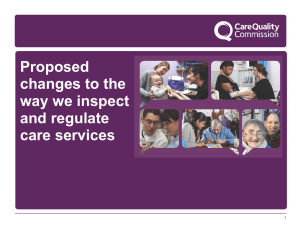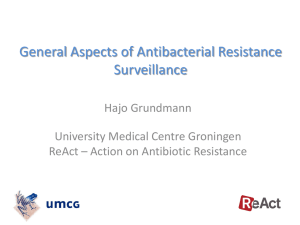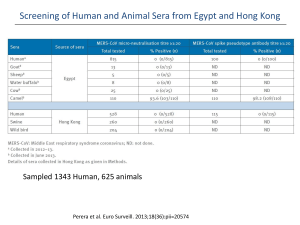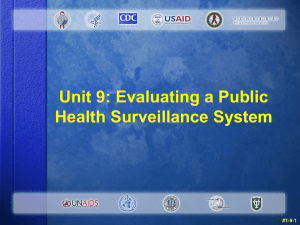Evaluating surveillance systems
advertisement
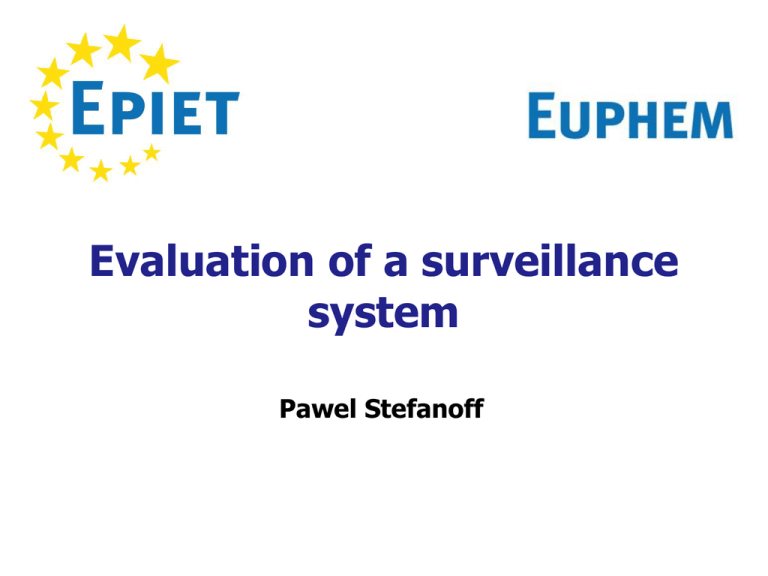
Evaluation of a surveillance system Pawel Stefanoff Evaluation of a surveillance system: a cyclic process Gaps between needs and capacities Monitoring and evaluation Planning for improvements Implementation WHAT do we want to assess? Surveillance system Complexity Disease specific surveillance Technique The way of defining the problem methods solution. Why evaluate? • To assess the capacity of the system to meet its purpose and objectives • In order to – improve its operation – modify it to address: • priorities • epidemiology – optimize the available resources Plan of evaluation • Description of the needs – Country context – Disease patterns – Target audience • Description of the surveillance system – Objectives – Process – Structure: resources, system • Analysis of attributes • Analysis of capacities /needs • Implementation of prioritized modifications Plan of evaluation • Description of the needs – Country context – Disease patterns – Target audience • Description of the surveillance system – Objectives – Process – Structure: resources, system • Analysis of attributes • Analysis of capacities /needs • Implementation of prioritized modifications Description of surveillance needs • Description of the country context – Population – Health system – Political structure and administration • Description of disease patterns: – Disease characteristics (epidemic potential) – Risk factors (country-specific?) What’s the target audience of surveillance? • Public Health professionals? • Clinicians / Microbiologists / Control of Infection staff? • Environmental Health professionals? • Health service managers? • Health educators / teachers? • Government / Politicians? • Public? Plan of evaluation • Description of the needs – Country context – Disease patterns – Target audience • Description of the surveillance system – Objectives – Process – Structure: resources, system • Analysis of attributes • Analysis of capacities /needs • Implementation of prioritized modifications Description of the surveillance system • The description of the surveillance system is a scientific process – Poor methods will generate unreliable results • When describing a surveillance system: – Report your methods in the “methods” section – Write the description in the “results” section Methods that may be used to describe a surveillance system 1. Review of documents 2. Review of products/ outputs 3. Qualitative interviews of key informants 4. Quantitative interviews of participants 1. Reviewing documents • Consider: – Work plans – Guidelines – Operation manuals – Forms • Generates information on the theoretical surveillance system 2. Reviewing products/ outputs • Consider: – Records – Data – Feedback reports • Generates information on the actual surveillance system Elements of the surveillance system to describe (1/2) • Diseases under surveillance • Forms used • Case definition • Population under surveillance – Total, sentinel or special • Reporting mode – Passive, stimulated or active Elements of the surveillance system to describe (2/2) • Data structure – Individual or aggregated • Data transmission – Flow chart • Data analysis procedures – Type, frequency • Feedback – Type, frequency • Action taken Define objectives of a surveillance system • Identify or help formulating the actual or desirable objective(s) of the surveillance system – Identify the goal of the programme served – Identify what decisions may need to be taken • Review the attributes of the system • Review whether the system’s attributes are satisfactory to reach the objective(s) Plan of evaluation • Description of the needs – Country context – Disease patterns – Target audience • Description of the surveillance system – Objectives – Process – Structure: resources, system • Analysis of attributes • Analysis of capacities /needs • Implementation of prioritized modifications System attributes • Simplicity • Flexibility • Acceptability • Data quality • Sensitivity • Positive predictive value • Representativeness • Timeliness • Cost Simplicity • Structure – information needed – number and type of sources – number of information users • Ease of operation – data transmission – system maintenance – data analysis – information dissemination Flowchart for surveillance of HIV/AIDS in Norway Reference laboratory Blood sample for HIV test Primary laboratory HIV reporting form, part 1 Lab report and HIV reporting form HIV infection Patient AIDS Death, emigration Primary care physician Hospital physician HIV reporting form, part 2 (Prompting if necessary) AIDS reporting form Semiannual check Oral information Semiannual check National Institute of Public Health Flexibility • Ability of the system to accommodate changes with little additional time, persons or allocated funds – New event to follow-up – New case definition – New data about an event – New sources of information Acceptability • Knowledge: – Case definition, notification procedures • Notification conditions – Sufficient stock of notification forms – Working charge – Simplicity • Motivation – Understanding the importance – Risk perception – Existence of a regular feedback Data quality Completeness and validity of the data recorded • Completenness of records – blanks in the surveillance forms • Errors when computing data • Influenced by – Simplicity of surveillance form – Clarity of electronic surveillance forms – Training – Validation Sensitivity • Two aspects: – proportion of cases of a disease or health condition detected by the surveillance system. – ability to detect outbreaks, to monitor changes (out of outbreaks, how many were detected) • Requires (in principle) – to validate the information collected and – to collect information outside of the system to determine the frequency of the condition in the community. Factors influencing case detection • The probability of medical consultation – Severity of symptoms – Access to health care – Social and cultural values and habits • The probability of clinical diagnosis – Pathogen causes a clinical condition also caused by other pathogens • The probability of lab diagnosis – Demand for lab-testing – Existence of laboratories with the specific technique Quantitative estimates of the sensitivity of a surveillance system • Health care facility survey – Proportion of cases seen in the health care facility that are reported / captured by the surveillance system • Population survey – Proportion of cases occurring in the population: • Seen in health care facilities • Reported / captured by the surveillance system • Mathematical model – Cases captured /expected Sensitivity of measles surveillance in Haora district, West Bengal, India • Methods used – Cluster sample with door to door case search – Review of health care facility and surveillance records • Key results: – Of 240 cases identified in the population, 8 (3.3%) were seen in public health care facilities and reported • Conclusion: – Measles surveillance is only 3.3% sensitive • Recommendation: – Promote vitamin A management in the population to increase the use of health system in the case of measles Positive Predictive Value • PPV depends on – sensitivity – specificity, and the – prevalence of the condition in the population • Consequence of a low PPV – – – – – frequent "false-positive" report inappropriate follow-up of non-cases incorrect identification of epidemics (artifacts) wastage of resources inappropriate public concern (credibility) Measles case definitions • Suspect case – rash and fever • Probable case – rash, fever, and (cough, coryza or conjunctivitis) – epidemiological link to a confirmed case • Laboratory confirmed – saliva/serum IgM positive Predictive value of notified measles Effect of change in incidence Non-measles Genuine measles 100 % 100000 80 % 10000 60 % 1000 40 % 100 20 % 10 1 0% Pre-vaccine Low coverage High coverage Near elimination PV+ Number of cases 1000000 Representativeness • Representative = accurately describing the distribution of a event health in the population by place and time • Related to – data quality – bias of data collection – completeness of reporting Timeliness • Delay / speed between steps in surveillance – onset – diagnosis – report – data entry – analysis – interpretation – intervention • Chronic vs acute disease Time Median delay between notification and intervention by public health services Shigellosis, Delaware, 1991 Notification completed (n = 216) Notification received (n = 264) Intervention (n = 255) 0 2 4 6 8 10 12 # days since onset of symptoms 14 Cost • Cost is the estimated economic cost of the system • Critical evaluation: – Could the system do an identical or better job while using less resources? Buehler's balance of systems attributes Sensitivity Representativeness Predictive value positive Timeliness Acceptability Flexibility Simplicity Cost Plan of evaluation • Description of the needs – Country context – Disease patterns – Target audience • Description of the surveillance system – Objectives – Process – Structure: resources, system • Analysis of attributes • Analysis of capacities /needs • Implementation of prioritized modifications Gaps between needs and capacities • Is the system able to – adapt to changing needs – detect cases and outbreaks – investigate and intervene – disseminate and exchange information identification of weaknesses Plan of evaluation • Description of the needs – Country context – Disease patterns – Target audience • Description of the surveillance system – Objectives – Process – Structure: resources, system • Analysis of attributes • Analysis of capacities /needs • Implementation of prioritized modifications Prioritisation of weaknesses to be addressed Weaknesses and their Prioritisation causes Objectives for improvement - Example 1 • Surveillance of HIV/AIDS in Spain – notification on AIDS cases – aggregate reporting by laboratories on new HIV diagnoses – sentinel clinics report on HIV testing • Which attributes are relevant? Example 2 • Surveillance for surgical site infections in a hospital – each patient after surgery is observed – complications are recorded on the observation card • Which attributes are relevant? Example 3 • Surveillance collecting information on viral meningitis in Poland – detection of enteroviral outbreaks – investigation for poliovirus – monitoring tick-borne encephalitis foci – identification of new neurotropic viruses • Which atributes are relevant?
